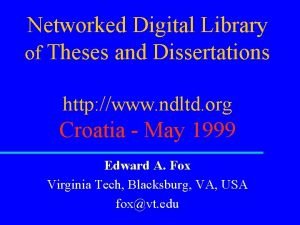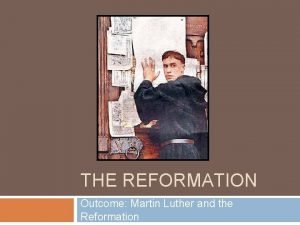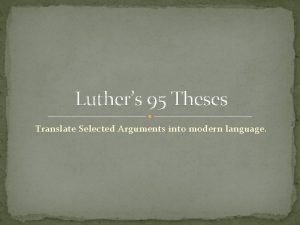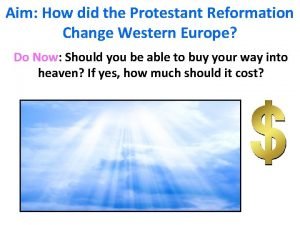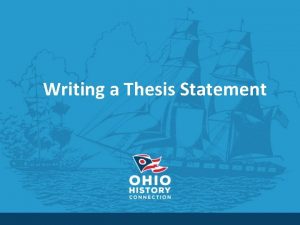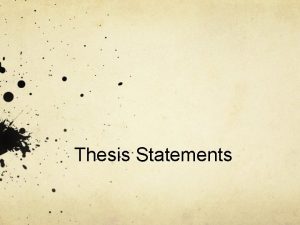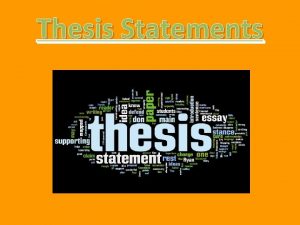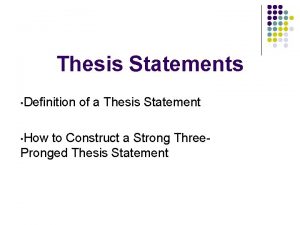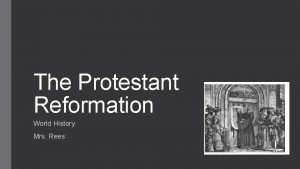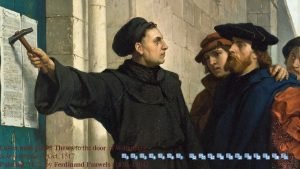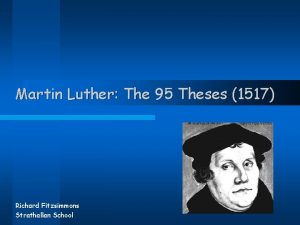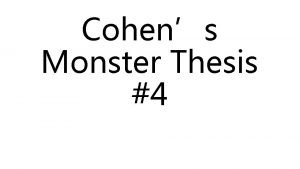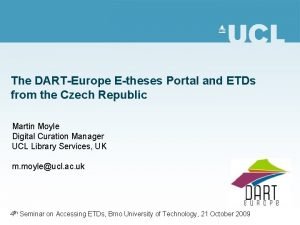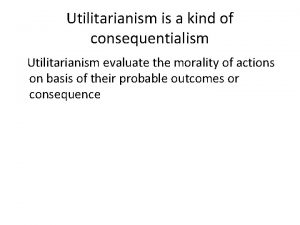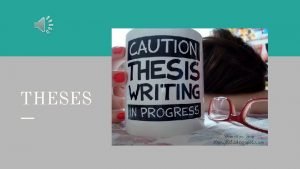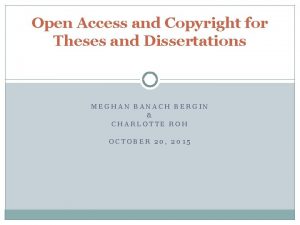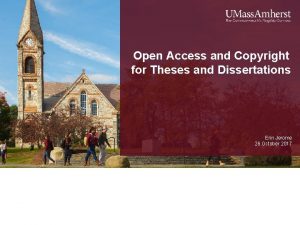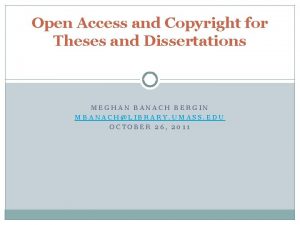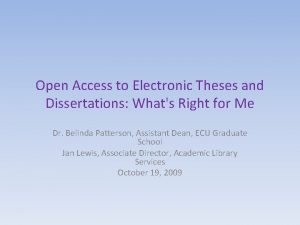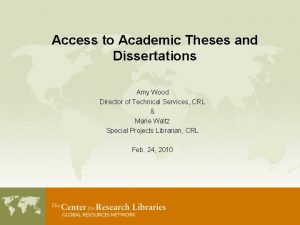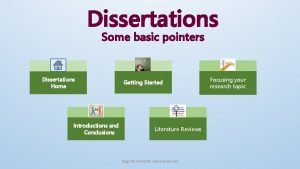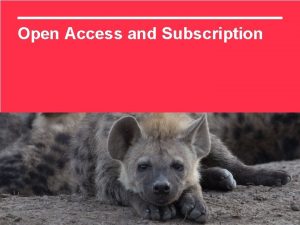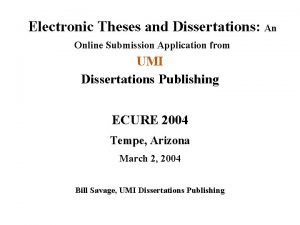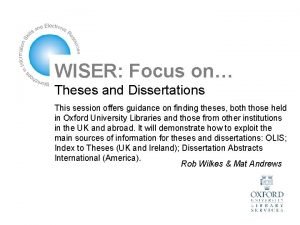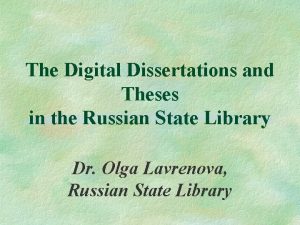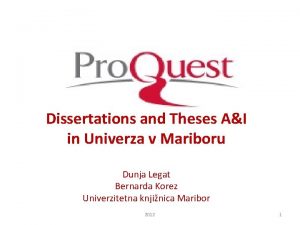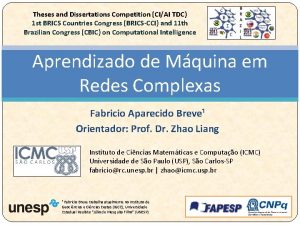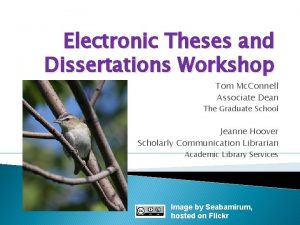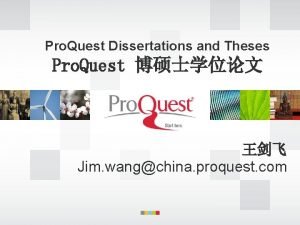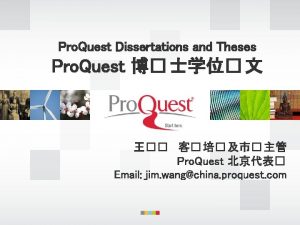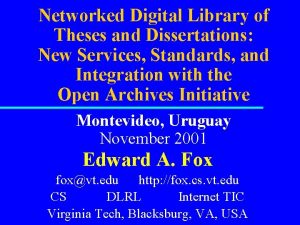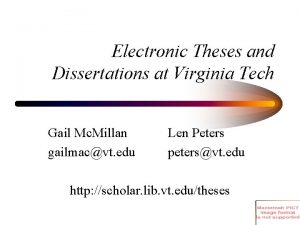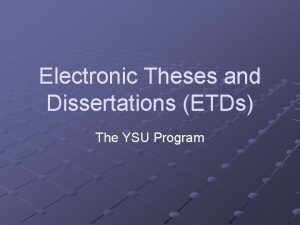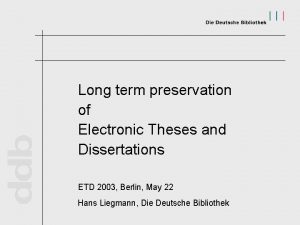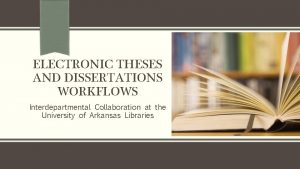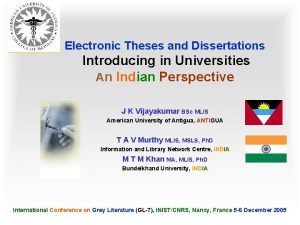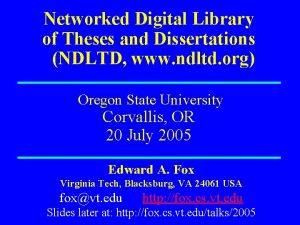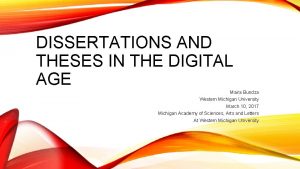Open Access and Copyright for Theses and Dissertations


























- Slides: 26

Open Access and Copyright for Theses and Dissertations ERIN JEROME OCTOBER 25, 2016

Scholar. Works @ Umass Amherst

Submitting your thesis or dissertation

Options for your dissertation or thesis: �Open access with embargo (for 6 months or 1 year) �Campus only access (for 1 year or 5 years) with embargo (for 6 months or 1 year)

Definitions �What does open access mean? �What exactly is campus access? �What is an embargo?

Reasons Some reasons you might be thinking about choosing campus access or an embargo: � Concerns about future publication � Concerns about applying for a patent � Concerns about private or sensitive information � Concerns about the use of copyrighted work in your thesis or dissertation

Videos �Open Access 101 http: //vimeo. com/6973160 �Benefits of Open Access http: //www. youtube. com/watch? v=y 9 Jh_Gff. RPU

Using Copyrighted Works In Your ETD There are several ways to do this legally: �Use public domain works or �Use openly licensed materials (such as those with a Creative Commons license) �Apply the fair use doctrine

Creative Commons

Creative Commons

Sources for Creative Commons Licensed Materials Music: Images: Video:

Public Domain �All works published before 1923 are in the public domain due to copyright expiration �For materials published after 1923 it’s more complicated

Copyright Slider http: //www. librarycopyright. net/resources/digitalslider/

The Four Factors of Fair Use 1. Purpose and character of the use 2. Nature of the copyrighted work 3. Amount of the portion used 4. Effect of the use upon the potential market

Purpose & Character of Use In Favor of Fair Use: � Teaching, research, or scholarship � Nonprofit Educational Institution � Comment or criticism � News reporting � Transformative use (such as parody for example) In Favor of Copyright Holder (not fair use): � Commercial activity � Profiting from the use � Entertainment � Bad-faith behavior � Denying credit to original author

Nature of the Copyrighted Work In Favor of Fair Use: �Published work �Factual or nonfiction based �Important to educational objectives In Favor of Copyright Holder (not fair use): �Unpublished work �Highly creative work (art, music, novels, films, plays) �Fiction

Amount of the Work In Favor of Fair Use: In Favor of Copyright Holder (not fair use): �Small quantity �Large portion or whole �Portion used is not work used central �Portion used is central to �Amount is appropriate for educational purpose work or significant to entire work or "heart of the work"

Effect on the Market: In Favor of Fair Use: � User owns or purchased copy of original work � One or few copies made � No significant effect on the market or potential market for copyrighted work � Restricted access (to students or other appropriate group) In Favor of Copyright Holder (not fair use): � Could replace sale of copyrighted work � Significantly impairs market or potential market for copyrighted work or derivative � Affordable permission or licensing easily available for using work � Numerous copies made � You made it accessible on Web or in other public forum

Text Direct Quotations: �Short direct quotations with attribution �For example, a paragraph or two �Most likely within the bounds of fair use

Images �If it is easy to license the right to use the images and the cost is reasonable: License the image �Images for which permission or a license is difficult or impossible to obtain: Use of the image without permission in a dissertation is probably a fair use

Music and Video �Obtain permission or license the works if possible and if the cost is reasonable �If there is no functional market for permission or licensing, your use will likely be fair use

Example � Masters Thesis: Trophy Children Don’t Smile by Chris Boulton � http: //scholarworks. umass. edu/theses/3/ � Discusses the depiction of children in magazine advertisements for children’s designer clothing brands. Uses copyrighted advertisements to illustrate his arguments

“Best Practices in Fair Use” �Discipline-specific guides to fair use �See especially: Documentary Filmmakers Scholarly Research in Communication Music Scholarship Dance-Related Materials Poetry Visual Resources Association Story Arts User-Generated Video �http: //centerforsocialmedia. org/fair-use/best-practices

Questions?

Additional Information � Brewer, Michael. American Library Association Office for Information Technology Policy, Copyright Advisory Committee. Digital Copyright Slider: http: //www. librarycopyright. net/digitalslider/ � California. State University, Long Beach, Thesis and Dissertation Office. Sample Permission letter: http: //www. csulb. edu/library/guide/serv/permis. html � Columbia University Libraries, Copyright Advisory Office. Requesting Permission: http: //copyright. columbia. edu/copyright/permissions/requesting-permission/ � Copyright Management Center, Indiana University Checklist for Fair Use. http: //www. copyright. iupui. edu/ � Creative Commons: http: //creativecommons. org/ � Gasaway, Lolly. University of North Carolina. When U. S. Works Pass into the Public Domain: http: //www. unc. edu/~unclng/public-d. htm � University of Minnesota Libraries, Copyright Use Map: http: //www. lib. umn. edu/copyright/usemap

Comments? Questions? Thank You for Your Attention! Contact Information: Erin Jerome 413 -545 -2174 ewjerome@library. umass. edu
 Networked digital library of theses and dissertations ndltd
Networked digital library of theses and dissertations ndltd Open innovation open science open to the world
Open innovation open science open to the world What drove martin luther to write the 95 theses
What drove martin luther to write the 95 theses 95 theses summary
95 theses summary 95 theses translation
95 theses translation Martin luther 95 theses summary
Martin luther 95 theses summary Examples of thesis statement
Examples of thesis statement What s a thesis statement
What s a thesis statement Umbrella thesis examples
Umbrella thesis examples Thesis statement definition
Thesis statement definition 95 theses rap
95 theses rap Martin luther nails 95 theses
Martin luther nails 95 theses How to restate a claim
How to restate a claim Martin luther king 95 theses
Martin luther king 95 theses Cohen monster theses
Cohen monster theses Dart-europe e-theses portal
Dart-europe e-theses portal Types of utilitarianism
Types of utilitarianism Roadmap thesis
Roadmap thesis Terminal access controller access control system
Terminal access controller access control system Terminal access controller access-control system
Terminal access controller access-control system Kontinuitetshantering i praktiken
Kontinuitetshantering i praktiken Typiska novell drag
Typiska novell drag Nationell inriktning för artificiell intelligens
Nationell inriktning för artificiell intelligens Ekologiskt fotavtryck
Ekologiskt fotavtryck Shingelfrisyren
Shingelfrisyren En lathund för arbete med kontinuitetshantering
En lathund för arbete med kontinuitetshantering Adressändring ideell förening
Adressändring ideell förening
